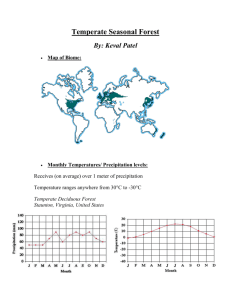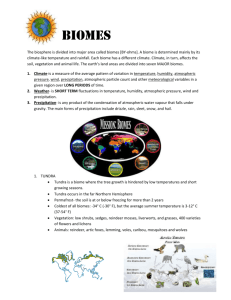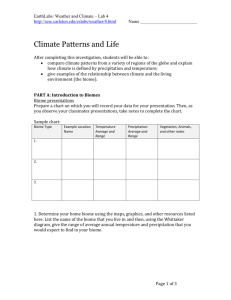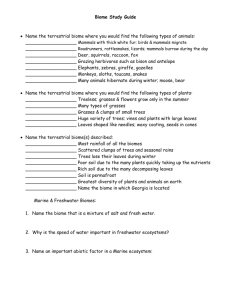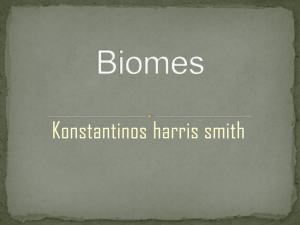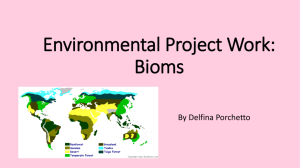BIOME FACT SHEET
advertisement
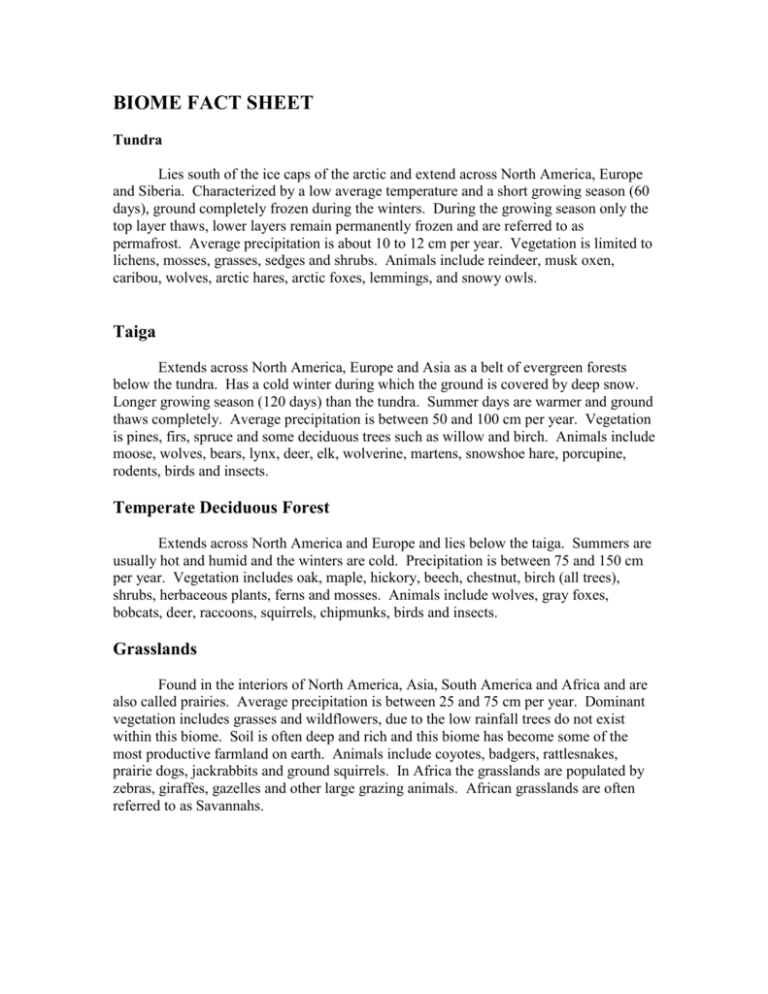
BIOME FACT SHEET Tundra Lies south of the ice caps of the arctic and extend across North America, Europe and Siberia. Characterized by a low average temperature and a short growing season (60 days), ground completely frozen during the winters. During the growing season only the top layer thaws, lower layers remain permanently frozen and are referred to as permafrost. Average precipitation is about 10 to 12 cm per year. Vegetation is limited to lichens, mosses, grasses, sedges and shrubs. Animals include reindeer, musk oxen, caribou, wolves, arctic hares, arctic foxes, lemmings, and snowy owls. Taiga Extends across North America, Europe and Asia as a belt of evergreen forests below the tundra. Has a cold winter during which the ground is covered by deep snow. Longer growing season (120 days) than the tundra. Summer days are warmer and ground thaws completely. Average precipitation is between 50 and 100 cm per year. Vegetation is pines, firs, spruce and some deciduous trees such as willow and birch. Animals include moose, wolves, bears, lynx, deer, elk, wolverine, martens, snowshoe hare, porcupine, rodents, birds and insects. Temperate Deciduous Forest Extends across North America and Europe and lies below the taiga. Summers are usually hot and humid and the winters are cold. Precipitation is between 75 and 150 cm per year. Vegetation includes oak, maple, hickory, beech, chestnut, birch (all trees), shrubs, herbaceous plants, ferns and mosses. Animals include wolves, gray foxes, bobcats, deer, raccoons, squirrels, chipmunks, birds and insects. Grasslands Found in the interiors of North America, Asia, South America and Africa and are also called prairies. Average precipitation is between 25 and 75 cm per year. Dominant vegetation includes grasses and wildflowers, due to the low rainfall trees do not exist within this biome. Soil is often deep and rich and this biome has become some of the most productive farmland on earth. Animals include coyotes, badgers, rattlesnakes, prairie dogs, jackrabbits and ground squirrels. In Africa the grasslands are populated by zebras, giraffes, gazelles and other large grazing animals. African grasslands are often referred to as Savannahs. Deserts Occur in regions that are too dry to support grasses with sandy and poor soil. Rainfall is usually less than 25 cm per year. In North America a desert extends from Mexico to the eastern part of Washington. Huge areas of desert are also found in South America, Africa, Asia and Australia. Temperatures vary from very hot during the day and may drop as much as 30 degrees Celsius at nighttime. Vegetation has special adaptations for conserving water and is often referred to as succulents. These plants include cacti, yucca, mesquite, sagebrush and creosote bush. Animals include fennec, snakes, lizards, spiders and insects. Tropical Rain Forest Found in areas around the equator with a fairly uniform climate throughout the year. Average precipitation is between 200 and 400 cm per year and occurs nearly every day. Temperatures remain constant at about 25 degrees Celsius throughout the year. They have an enormous variety of flora (plants) and fauna (animals) and are some of the most biodiverse ecosystems on the planet. Trees may form canopies above the ground as much as 50 meters high. Many trees will have roots with braces, or buttresses, that extend from the trunks to the ground to support these very tall plants. Over 100 different varieties of plants exist in this biome and may include lianas and epiphytes. Animals include monkeys, bats, squirrels, parrots, snakes, lizards, rodents, tapir, antelope, deer, spiders, insects, ants, termites, bees, butterflies and moths Chaparral The chaparral biome is found in a little bit of most of the continents - the west coast of the United States, the west coast of South America, the Cape Town area of South Africa, the western tip of Australia and the coastal areas of the Mediterranean. The chaparral biome has many different types of terrain. Some examples are flat plains, rocky hills and mountain slopes. It is sometimes used in movies for the "Wild West". It is characterized as being very hot and dry. As for the temperature, the winter is very mild and is usually about 10 °C. Then there is the summer. It is so hot and dry at 40 °C that fires and droughts are very common. The plants and animals are adapted to these conditions. Most of the plants have small, hard leaves which hold moisture. Some of these plants are poison oak, scrub oak, yucca wiple and other shrubs, trees and cacti. The animals are all mainly grassland and desert types adapted to hot, dry weather. A few examples: coyotes, jack rabbits, mule deer, alligator lizards, horned toads, praying mantis, honey bee and ladybugs.


